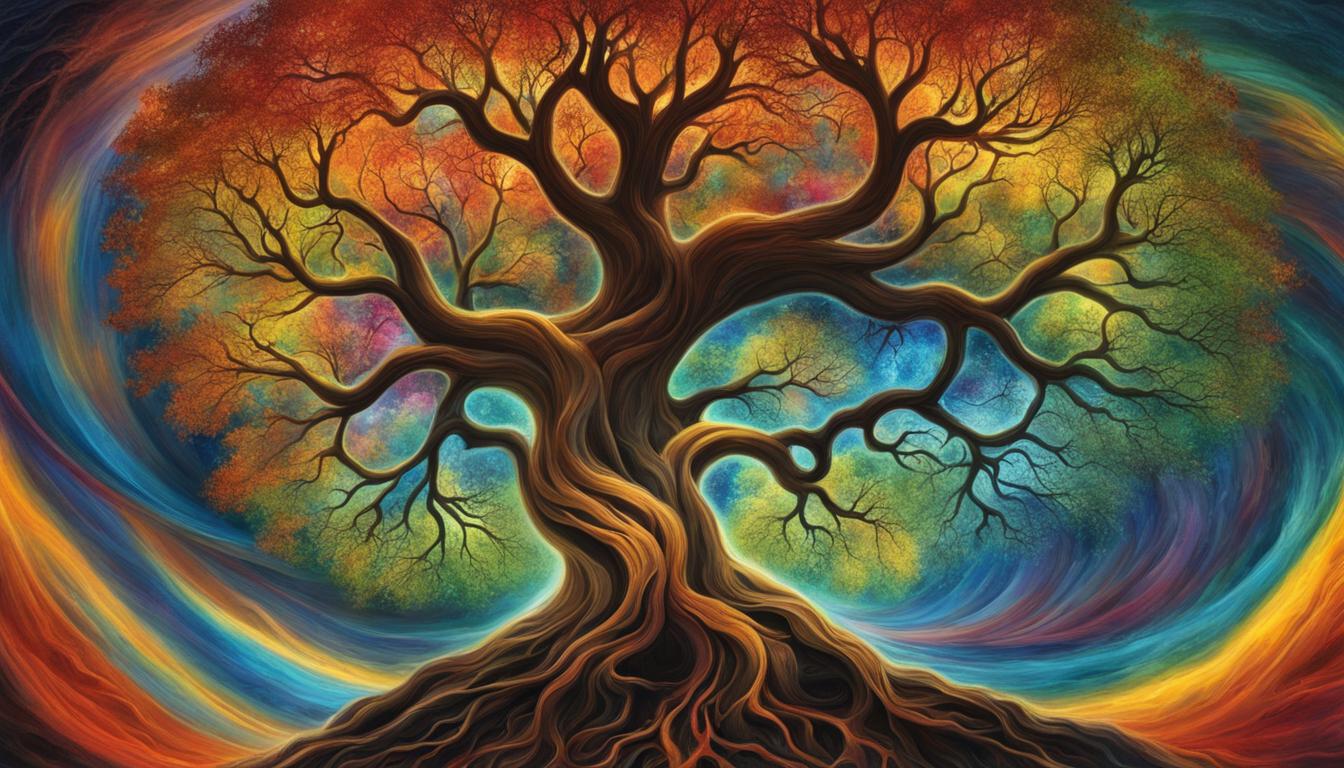Chakras, the ancient focal points of energy used in Hindu and Buddhist meditation practices, have a rich history that spans centuries. Understanding the origins and development of chakras is key to gaining a deeper appreciation for their significance in different spiritual and holistic practices.
In early Hindu traditions, references to chakras can be found in Sanskrit texts as both meditative visualizations and physical entities within the body. The concept of chakras originated in Hinduism, with Buddhist texts also mentioning them, albeit with variations in the number of chakras mentioned.
Fast forward to the late 19th century, when the teachings of Theosophists and the writings of authors like Sir John Woodroffe and Charles W. Leadbeater shaped the modern Western understanding of chakras. This interpretation added psychological attributes, rainbow colors, and connections to other systems such as astrology and tarot.
Key Takeaways:
- Chakras originated in Hindu and Buddhist traditions.
- The number of chakras mentioned varies between Buddhist and Hindu sources.
- The modern Western understanding of chakras evolved from the teachings of Theosophists.
- Western interpretation added psychological attributes, rainbow colors, and connections to other systems.
- Understanding the origins and evolution of chakras enhances their significance in different practices.
The Ancient Concept of Chakras in Hinduism and Buddhism
The ancient concept of chakras holds deep significance in both Hinduism and Buddhism. In Hindu traditions, chakras are considered to be energy centers within the body, where physical and spiritual energies intersect. These focal points serve as gateways to higher consciousness and play a vital role in Tantric Yoga practices.
The early Sanskrit texts offer detailed guidance on activating and balancing the chakras through visualization and meditation techniques. These practices involve specific breathing exercises, hand gestures (mudras), and sacred sounds (mantras) to influence the flow of energy through the body. By focusing on each chakra, practitioners aim to harmonize their spiritual, emotional, and physical well-being.
Buddhist texts also acknowledge the presence of chakras, emphasizing the five main ones. These chakras serve as focal points for meditation and the manipulation of subtle energy. Buddhist practices related to chakras include concentration exercises, visualizations, and mindfulness techniques to cultivate awareness and insight. By working with these chakras, individuals seek to attain spiritual awakening and liberation.
Table: Comparing Traditional Chakra Practices in Hinduism and Buddhism
| Aspect | Hinduism | Buddhism |
|---|---|---|
| Number of Chakras | Six or Seven | Five |
| Practices | Visualization, Meditation, Breathing Exercises, Mudras, Mantras | Concentration, Visualization, Mindfulness |
| Goal | Harmonizing spiritual, emotional, and physical well-being | Spiritual awakening and liberation |
The ancient concept of chakras in Hinduism and Buddhism demonstrates the rich esoteric traditions that have been passed down through generations. These practices encourage individuals to explore their inner realms, cultivate self-awareness, and embark on transformative journeys. Whether you resonate with the Hindu or Buddhist approach, incorporating chakra practices can deepen your spiritual connection and enhance your overall well-being.
The Evolution of the Western Chakra System
The modern understanding of chakras in the Western world has undergone a significant evolution over time. This transformation can be attributed to the influence of Western thinkers who have expanded upon and integrated the concept of chakras with other systems. One of the key figures in this development was H.P. Blavatsky, a prominent Theosophist in the late 19th century. Blavatsky’s writings introduced the idea of chakras to Western audiences and sparked further exploration into their significance.
Subsequent to Blavatsky, other notable authors such as Sir John Woodroffe and Charles W. Leadbeater further developed the Western understanding of chakras. These authors not only popularized the concept but also added new layers of interpretation. They associated each chakra with specific psychological attributes and assigned them vibrant rainbow colors, which differed from the more subtle representations found in the original Hindu and Buddhist teachings.
The Western chakra system also took inspiration from other esoteric traditions, such as astrology and tarot. Each chakra was linked to astrological signs, metals, and symbolic representations like lotus flowers and geometric shapes. These associations provided a comprehensive framework for exploring the connections between chakras and various aspects of human experience.
Integration of Chakras with Other Systems
The integration of chakras with other systems in the Western context allowed for a broader understanding and application of these energy centers. By associating chakras with colors and symbols, they became more accessible and easier to comprehend for Western audiences. Furthermore, the incorporation of psychological attributes expanded the potential for self-exploration and personal development.
It is important to note, however, that these additional associations and interpretations may not align with the original teachings from Hinduism and Buddhism. While the Western chakra system offers its own unique perspective, it is essential to approach it with an understanding of its cultural evolution and divergence from the traditional practices.
| Chakra | Associated Color | Astrological Sign | Symbolic Representation |
|---|---|---|---|
| Muladhara (Root Chakra) | Red | Aries | Lotus with four petals |
| Svadhisthana (Sacral Chakra) | Orange | Pisces | Lotus with six petals |
| Manipura (Navel Chakra) | Yellow | Leo | Lotus with ten petals |
| Anahata (Heart Chakra) | Green | Libra | Lotus with twelve petals |
| Vishuddha (Throat Chakra) | Blue | Gemini | Lotus with sixteen petals |
| Ajna (Third Eye Chakra) | Indigo | Sagittarius | Lotus with two petals |
| Sahasrara (Crown Chakra) | Purple | Capricorn | Lotus with a thousand petals |
Table: Chakra Associations in the Western Chakra System
Understanding the Seven-Chakra System
The seven-chakra system is the most well-known and widely studied in the West. These chakras are believed to play a significant role in our overall health and well-being. Each chakra is associated with specific functions and located along the spinal column, from the base of the spine to the crown of the head.
The major chakras in the seven-chakra system are:
- Muladhara (root chakra)
- Svadhisthana (sacral chakra)
- Manipura (navel chakra)
- Anahata (heart chakra)
- Vishuddha (throat chakra)
- Ajna (third eye chakra)
- Sahasrara (crown chakra)
Each chakra is associated with unique aspects of our physical, emotional, and spiritual well-being. For example, the root chakra, located at the base of the spine, is associated with our sense of safety, security, and basic survival instincts. The heart chakra, located in the center of the chest, is linked to love, compassion, and emotional balance.
Imbalances in these chakras can manifest as physical, emotional, or spiritual issues. Chakra-based therapies aim to restore balance and harmony by working with the energy centers. These therapies can include practices such as meditation, yoga, sound healing, and energy work. By addressing imbalances and blockages in the chakras, individuals can experience improved overall well-being and a greater sense of harmony within themselves.
Table: Overview of the Seven-Chakra System
| Chakra | Location | Associated Functions | Keywords |
|---|---|---|---|
| Muladhara (root chakra) | Base of the spine | Security, stability, survival instincts | Grounding, stability, fear |
| Svadhisthana (sacral chakra) | Lower abdomen | Creativity, sexuality, pleasure | Passion, joy, sensuality |
| Manipura (navel chakra) | Solar plexus | Personal power, confidence, digestion | Personal power, self-esteem, willpower |
| Anahata (heart chakra) | Center of the chest | Love, compassion, emotional balance | Love, forgiveness, compassion |
| Vishuddha (throat chakra) | Throat | Communication, self-expression, truth | Expression, communication, creativity |
| Ajna (third eye chakra) | Forehead, between the eyebrows | Intuition, perception, spiritual awareness | Intuition, clarity, imagination |
| Sahasrara (crown chakra) | Top of the head | Higher consciousness, spiritual connection | Spirituality, enlightenment, divine |
Conclusion
In conclusion, understanding the origins and evolution of chakras provides valuable insights into these ancient energy centers. Chakras have their roots in Hindu and Buddhist traditions, where they were regarded as focal points of energy and consciousness. The concept of chakras has evolved over time, particularly in the Western context, incorporating ideas from various occult and esoteric traditions.
While scientific evidence for chakras is limited, many individuals report experiencing benefits from chakra-based practices such as meditation, yoga, and energy healing. These practices can help promote relaxation, balance, and overall well-being. However, it’s important to note that chakra-based therapies should not be seen as a substitute for professional medical treatment.
Understanding the cultural and historical context of chakras is crucial in appreciating their significance in different spiritual and holistic practices. Chakras hold deep meaning within the Hindu and Buddhist traditions, and their interpretation has extended to the Western world. By embracing the cultural context of chakras, we can gain a deeper understanding of ourselves and our spiritual journey.
In summary, while the origins of chakras may be shrouded in history, their impact on our well-being is evident. Embracing chakra-based therapies can complement traditional medical care, contributing to our overall health and happiness. So, dive into the realm of chakras, explore their potential, and discover the transformative power they hold.
FAQ
What are chakras?
Chakras are ancient focal points of energy used in Hindu and Buddhist meditation practices. They are believed to be energy centers where spiritual and physical energies intersect.
How many chakras are there?
The number of chakras mentioned varies between Buddhist and Hindu sources, with Buddhist texts generally referring to five, and Hindu sources mentioning six or seven.
Where did the concept of chakras originate?
The concept of chakras originated in the early traditions of Hinduism and played a significant role in Tantric Yoga practices. They are described in Sanskrit texts as both meditative visualizations and physical entities within the body.
How did the Western understanding of chakras evolve?
The modern Western understanding of chakras evolved from the teachings of Theosophists in the late 19th century and later writings by authors like Sir John Woodroffe and Charles W. Leadbeater. Western thinkers added psychological attributes, rainbow colors, and connections to other systems such as astrology and tarot to the concept of chakras.
What is the seven-chakra system?
The most well-known chakra system in the West is the seven-chakra system, which includes the Muladhara (root chakra), Svadhisthana (sacral chakra), Manipura (navel chakra), Anahata (heart chakra), Vishuddha (throat chakra), Ajna (third eye chakra), and Sahasrara (crown chakra). These chakras are believed to be located along the spinal column, each associated with specific functions and aspects of health.
Are chakras scientifically proven?
The scientific evidence for chakras is limited. However, many individuals report experiencing benefits from chakra-based practices such as meditation, yoga, and energy healing.








